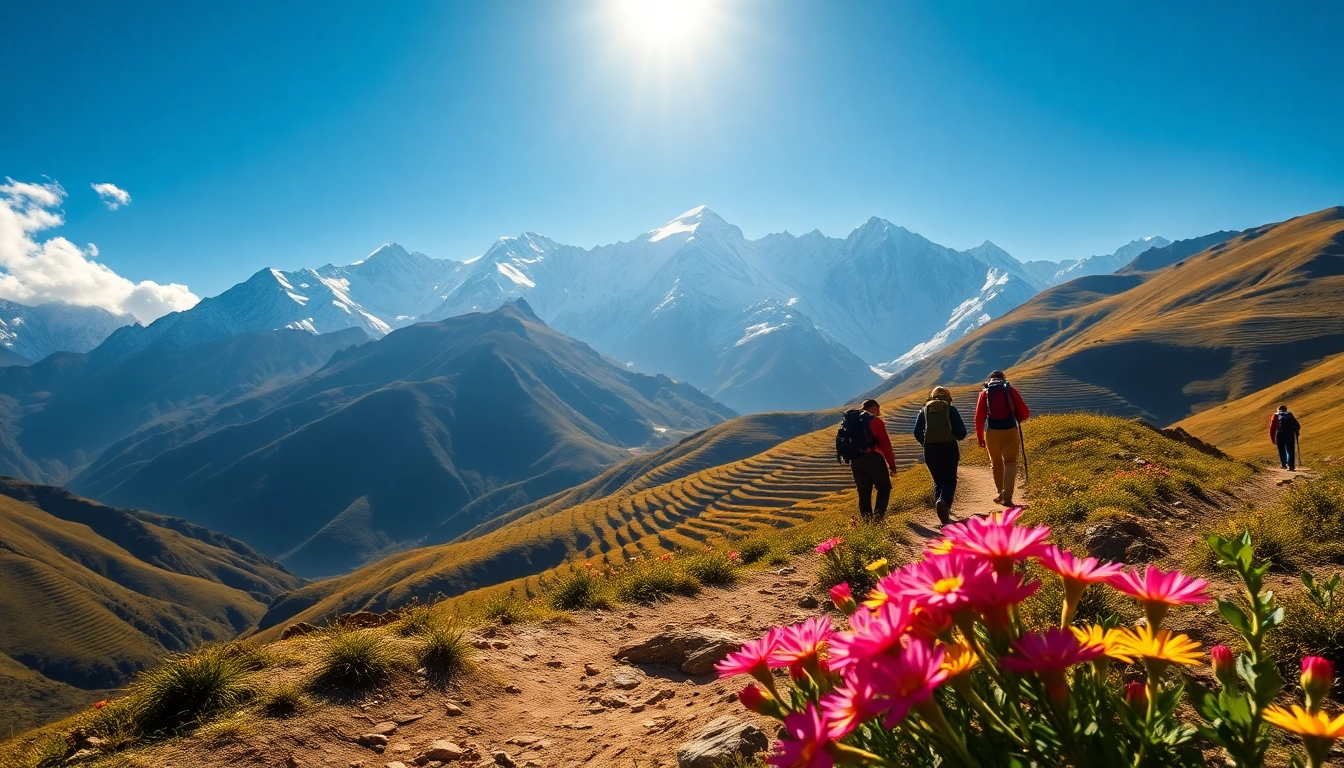Introduction to Annapurna Circuit Trek
The Annapurna Circuit Trek is an extraordinary journey renowned among trekkers worldwide. Nestled in the majestic Himalayas of Nepal, this trek offers a panoramic display of breath-taking peaks, diverse landscapes, and rich cultural experiences. The sheer beauty and complexity of this trail make it a bucket-list journey for adventurers, nature lovers, and cultural enthusiasts alike.
What is the Annapurna Circuit Trek?
The Annapurna Circuit is a long-distance trekking route that traverses the Annapurna mountain range in Nepal. Spanning approximately 160–230 kilometers (100-145 miles), depending on the chosen path and access to vehicular transport, this trek is characterized by its stunning variations in scenery, altitude, and climate.
The Annapurna Circuit offers trekkers a chance to witness some of the planet’s highest peaks, including Annapurna I, which rises to 8,091 meters (26,545 feet), and Dhaulagiri, known for its striking ice formations. The trek typically begins in Besisahar and ends at Jomsom, incorporating diverse landscapes ranging from lush subtropical forests, terraced fields, traditional villages, to high-altitude deserts.
Historical Significance of the Annapurna Circuit Trek
The Annapurna Circuit has been a prominent trail since the late 1970s when it was first opened to foreign trekkers. It holds significant historical value in the realm of mountaineering, as it was one of the first major trekking routes opened in Nepal. The trail is not just a pathway through the mountains; it symbolizes the connection between various communities, traditions, and the natural environment of the Himalayas.
Over the decades, the circuit has witnessed the evolution of trekking culture, reflecting the changing social and economic scenarios in the region. The interaction between ethnic groups like the Gurungs, Thakalis, and Tibetans has made it a cultural melting pot where ancient traditions blend seamlessly with modern influences.
Overview of Trek Difficulty and Duration
The Annapurna Circuit is generally regarded as a moderate to challenging trek, making it suitable for trekkers with varying levels of experience. The trek typically spans between 12 to 22 days, depending on the chosen itinerary and pace. Trekkers will encounter steep ascents, fluctuating altitudes, and changing weather conditions, which can add to the difficulty.
High-altitude trekking place demands on physical capabilities, primarily when approaching Thorong La Pass at an elevation of 5,416 meters (17,769 feet). Acclimatization is crucial to ensure safety and health during the trek, as climbers may face altitude sickness. Overall, the combination of beautiful terrain, cultural encounters, and personal challenge makes this trek an unforgettable experience.
Planning Your Annapurna Circuit Trek
Best Time to Undertake the Annapurna Circuit Trek
The optimal time to embark on the Annapurna Circuit is during the spring (March to May) and autumn (September to November) seasons. These months usually provide stable weather conditions, which are perfect for trekking. Spring offers a vibrant display of wildflowers, while autumn provides stunning vistas of well-defined trails against a clear, blue sky.
During these seasons, temperatures range from 10°C to 25°C (50°F to 77°F) in lower altitudes and may drop to -10°C (14°F) or lower at higher altitudes. The monsoon season from June to August brings heavy rain, which can make trails muddy and increase the risk of landslides, while winters can be harsh, leading to trail closures due to snow.
Necessary Permits and Regulations
Before setting foot on the Annapurna Circuit, trekkers must secure specific permits. The two primary permits required are:
- Annapurna Conservation Area Permit (ACAP): This permit is mandatory for anyone trekking within the Annapurna Conservation Area. It helps fund local conservation efforts and ensures that the pristine environment remains protected for future generations’ enjoyment.
- Trekkers’ Information Management System (TIMS) Card: Requiring registration for trekking routes, the TIMS Card is crucial for obtaining essential support and services along the trail. It helps in maintaining the safety of trekkers in the region.
It is recommended to arrange these permits through a licensed trekking agency in Nepal for a smooth process. Always keep the permits in a safe place, as they are periodically checked along the trail.
Essential Gear for the Annapurna Circuit Trek
Packing the right gear for the Annapurna Circuit Trek is crucial for both comfort and safety. Here’s a list of essential items trekkers should consider:
- Footwear: A pair of sturdy trekking boots with good ankle support and a comfortable, moisture-wicking pair of socks.
- Clothing: Layered clothing including moisture-wicking base layers, insulating mid-layers, and waterproof outer layers to adapt to changing weather conditions.
- Sleeping Gear: A lightweight sleeping bag rated for sub-zero temperatures if planning to camp.
- Backpack: A durable, lightweight backpack to carry your essentials.
- Safety Gear: A first aid kit, personal medications, and safety items like a whistle and a headlamp are essential for trekking safety.
- Hydration: Water purification tablets or filters to ensure safe drinking water in the mountains.
It’s wise to invest in quality gear, as this can significantly enhance the trekking experience and ensure safety along the way.
Navigating the Annapurna Circuit Trek Route
Key Stops and Attractions on the Annapurna Circuit Trek
The Annapurna Circuit boasts numerous picturesque stops along the way. Notable attractions include:
- Besishahar: The starting point for many trekkers, this town provides logistical support, including accommodations and supplies.
- Manang: Known for its stunning mountain views and unique culture, this village is a perfect acclimatization stop, offering numerous guesthouses and local food options.
- Thorong La Pass: The highest point of the trek at 5,416 meters, where trekkers are rewarded with breathtaking 360-degree views of the Himalayas.
- Muktinath Temple: A sacred site for both Hindus and Buddhists, adding a spiritual dimension to the trek.
- Jomsom: A major stop for trekkers and a gateway to the beautiful landscapes of the lower Mustang region.
The incredible diversity of landscapes, cultures, and experiences along the route makes each stop a unique chapter in the trekking journey.
Daily Itinerary and Distance Breakdown
A common itinerary for the Annapurna Circuit can range from 12 to 22 days, depending on the pace and chosen side trips. Below is a sample breakdown of a typical 14-day trek:
- Day 1: Besishahar to Bhulbhule (6-7 hours, 15 km)
- Day 2: Bhulbhule to Jagat (6-7 hours, 20 km)
- Day 3: Jagat to Dharapani (5-6 hours, 12 km)
- Day 4: Dharapani to Chame (5-6 hours, 12 km)
- Day 5: Chame to Pisang (5-6 hours, 14 km)
- Day 6: Pisang to Manang (7-8 hours, 24 km)
- Day 7: Acclimatization Day in Manang
- Day 8: Manang to Yak Kharka (3-4 hours, 10 km)
- Day 9: Yak Kharka to Thorong Phedi (5-6 hours, 13 km)
- Day 10: Thorong Phedi to Thorong La Pass to Muktinath (8-9 hours, 15 km)
- Day 11: Muktinath to Kagbeni (5-6 hours, 11 km)
- Day 12: Kagbeni to Jomsom (3-4 hours, 10 km)
- Day 13: Jomsom to Marpha, then to Tukuche (5-6 hours, 15 km)
- Day 14: Tukuche to Beni, concluding the trek
This itinerary allows for a gradual increase in elevation and affords trekkers the opportunity to acclimatize properly.
Altitude Considerations on the Annapurna Circuit Trek
Elevation gains are a crucial aspect of the Annapurna Circuit. Trekkers must be conscious of altitude sickness, which can impact anyone despite fitness level or prior experience. Here are some signs to watch for:
- Headache
- Nausea and vomiting
- Dizziness and loss of coordination
- Shortness of breath
To mitigate these risks, it’s important to embrace the principle of “climb high, sleep low.” Trekkers should ascend slowly, taking time to acclimatize at key points, especially at elevations exceeding 3,000 meters (9,842 feet). Additionally, staying hydrated is fundamental, as it helps with acclimatization.
Experiencing Culture on the Annapurna Circuit Trek
Local Communities and Interaction
The Annapurna Circuit Trek immerses trekkers in local cultures. Various ethnic communities inhabit the circuit, such as the Gurung, Thakali, and Tibetan peoples, known for their hospitality and cultural traditions.
Communities welcome trekkers with open arms, offering opportunities to learn about their way of life, customs, and share traditional meals. Engaging with locals is an enriching experience that deepens the understanding of the region’s history and lifestyle.
Cultural Festivals Along the Annapurna Circuit Trek
The Annapurna region celebrates various cultural festivals that reflect the rich heritage of its communities. Major festivals include:
- Dashain: A significant Hindu festival representing the victory of good over evil, celebrated with family gatherings, feasting, and rituals.
- Tihar: Also known as the festival of lights, this festival honors various animals, including crows, dogs, and cows, highlighting the importance of every creature in the ecosystem.
- Losar: The Tibetan New Year, celebrated broadly in the Mustang region, featuring traditional dances, music, and feasting.
Trekking during these festivals provides a unique glimpse into vibrant cultural expressions and celebrations, making the experience unforgettable.
Traditional Cuisine to Try During the Annapurna Circuit Trek
Culinary experiences are integral to the Annapurna Circuit Trek. Trekkers can savor local delicacies, most notably:
- Dal Bhat: A quintessential Nepali staple comprising lentil soup and rice, often served with vegetables and pickles.
- Momo: These dumplings come filled with various ingredients, including meat and vegetables, and are a popular snack.
- Thukpa: A hearty noodle soup with meat and vegetables, perfect for replenishing energy after a day of trekking.
- Chura: Flattened rice often served with yogurt and fruit, providing a nutritious breakfast option on the trail.
Sampling local cuisine not only satisfies the palate but also connects trekkers to the local culture.
Safety and Tips for the Annapurna Circuit Trek
Health and Safety Precautions on the Annapurna Circuit Trek
Safety is paramount while trekking the Annapurna Circuit. Here are several essential precautions:
- Travel with a group or a guide to ensure help is available in case of an emergency.
- Regularly assess physical conditions, especially regarding altitude sickness. Always communicate any concerns to your trekking companions.
- Be prepared for changing weather conditions and ensure your gear is suitable for temperature fluctuations.
Keeping a safe and steady pace while staying hydrated is crucial for maintaining energy levels throughout the trek.
Common Challenges Trekking Annapurna Circuit Trek
While varied landscapes and cultural experiences augment the trek’s uniqueness, several challenges may arise:
- Altitude Sickness: As mentioned earlier, it is vital to monitor health and acclimatize properly to avoid complications.
- Weather Conditions: Sudden storms or snowfall can impact visibility and trail accessibility. Always have contingency plans and know the nearest safe spots.
- Trail Conditions: Some stretches can be muddy or eroded. Proper footwear and exercise caution during treks, especially in wet conditions.
Awareness of these challenges can make a trekker better prepared to handle them effectively.
Support Resources and Emergency Contacts
Access to reliable support resources ensures safety during the Annapurna Circuit Trek. Important contacts include:
- Local Guides: Hiring a reputable local guide enhances safety and provides deeper insights into the region.
- Health Facilities: Familiarize with the locations of medical facilities before starting, especially in places like Manang and Jomsom.
- Emergency Numbers: Keep a list of essential emergency contacts, including local authorities and your country’s embassy in Nepal.
Staying informed empowers trekkers to navigate challenges effectively while enjoying the journey across the Annapurna Circuit.



